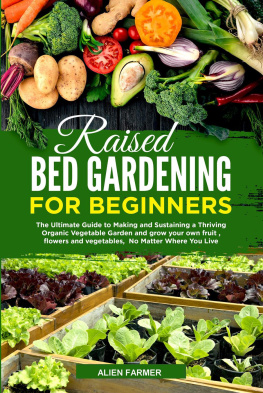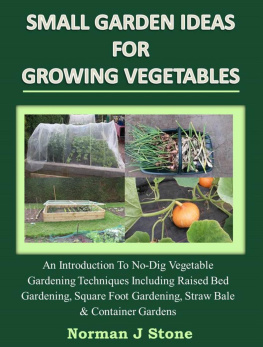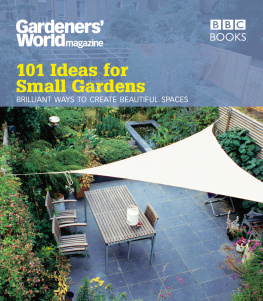
SMALL-SPACE
VEGETABLE GARDENS
Growing Great Edibles in Containers, Raised Beds, and Small Plots

ANDREA BELLAMY

To my daughter, Lila,
and future gardeners everywhere.
Contents

This tiny garden supplies everything from herbs to vegetables to fruit.
Preface
All around us, a movement is taking place. People are rigging up window boxes for growing herbs, making room on the fire escape for a pot of tomatoes, renovating neglected flower beds to make way for raspberries and rhubarb, and convincing landlords to turn over a few square feet of lawn for food production. Families are joining waitlists for community garden plots, signing up for canning workshops, and getting to know their local growers at the farmers market.
The economy, self-sufficiency, sustainability, taste, healthwhatever your reasons, it is always a good time to grow your own organic food. And you can do it, no matter how small your gardening space.
I grow food for all these reasons, but most of all I do it because it feels great. I love working outside and getting my hands dirty. I love connecting with other gardeners and sharing seeds and ideas. And I love harvesting something I have grown and eating it fresh that night for dinner. Yes, it is local foodreally local food. But mainly its just good food.
For me, gardening has been a lifelong obsession and an experiment in trial and error. Lots of error. And, believe it or not, that is something I love about growing foodit keeps me on my toes. Just when I think Ive finally mastered this urban farming thing, nature proves me wrong. The key, I think, is to pay attentionto celebrate each perfect potato, learn from mistakes, and, above all, enjoy the process.
This book walks you through the basicsand then someof planning, creating, and tending an organic food garden in a small space. This is the book I wish Id had when I was a new gardener, and I hope it will be a helpful resource and an inspiration to you. Most of all, I hope you get hooked on gardening and growing your own good food.


Gardens can happen in the most unexpected places.
Finding Space
Not all that long ago, vegetable gardens were relegated to the backyard. Tucked away from the eyes of neighbors and visitors, the veggie patch was often plain and utilitarian. It served one function: to feed the family.
Now, edibles are everywhereeven on the grounds of the White House. And not only gardeners are doing the growing. Foodies are discovering the fresh flavors of homegrown produce and herbs. Self-sufficient types are learning how to feed themselvesfrom seed to plate. Many of us are trying to lighten our carbon footprint and save money by eating closer to home. Finally, the veggie patch is having its day.
As popular as growing our own food has become, few people have a spare 200 square feet for a vegetable garden. What you may have, howeveror have access tois a balcony, a patio, a plot in a community garden, or even a small yard. Happily, thats all you need to create a bounty of edibles that can bring sustenance and personal satisfaction.
But first: Where to get growing?

Thinking Outside the Plot
Almost everyone has access to more space than they realize. It just takes a little creative thinking to see it. I didnt have the space to grow both peas and beans inside the confines of my patio, for example, so I co-opted the back side of my fence, which separates my patio from an alley. In only a narrow strip of soil at the base of the fence, I planted a family of pole beans, which climb up twine attached to the fence.
Take a look at your back alley: Could you install narrow raised beds along the alleys edge? Take a look at your sidewalk: Could you grow food in the space between it and the street? Take a look at any hard outdoor surfaces: Could you have a container garden on your driveway, porch, fire escape, or staircase? Take a look at your rooftop: Is it flat and relatively easy to access? (Remember that you will have to get pots, soil, and water up there, too.) Could it support the weight of a container garden? Take a look at the land surrounding your building: Could you convince your landlord or homeowners association to let you start a garden?

Fortex pole beans grow up a sunny exterior panel of my fence.
Container Gardens
When gardening on a rooftop, balcony, or other similar place lacking in soil, containers may be your only option. Or perhaps you just like the visual impact or control offered by gardening in pots. Luckily, you can find a nearly endless variety of container stylesfrom rustic to modern and everything in between. And with a large enough container, you can grow almost anything in a poteven fruit trees.
PROS Visual impact provided by colorful or unique containers. You can also provide perfect soil, move pots around, create a garden where there isnt one, reduce soil compaction, and control pests and weeds.
CONS Pots can dry out quickly or become waterlogged if drainage is insufficient. Nutrients must be replaced frequently. Plants can become root-bound if pot is too small.

Vertical container growing makes this balcony welcoming and productive.
Community Gardens
The classic solution to the space-shortage problem, community gardens have been around in various forms for centuries. Whether gardened communally or clearly divided into individual plots, community gardensand their British counterpart, allotment gardenscan be great places to get growing. In addition to paying an annual plot fee, gardeners are usually expected to help maintain the overall health of the garden by doing basic garden tasks (such as weeding the common areas or maintaining the compost bin) or by contributing their time through fundraising or other administrative tasks. In exchange, youll typically get a plot of your own, along with access to the tools to maintain it.
PROS Meeting your neighbors, learning from more experienced gardeners, and sharing resourcesoften including water, compost, and garden tools. Usually, the cost for an allotment or plot is reasonable, or even waived for those with lower incomes.
CONS You may have to wait a while to get a space; waiting lists can be long. If the garden is far from your home, it can be inconvenient to maintain and harvest. Theft can also be an issue.

Next page















